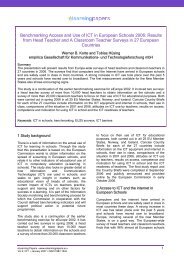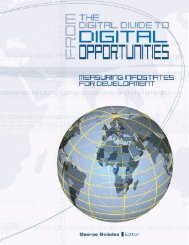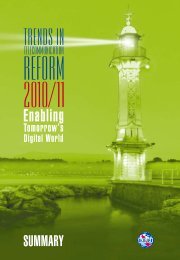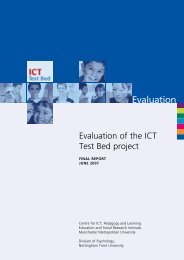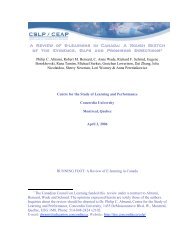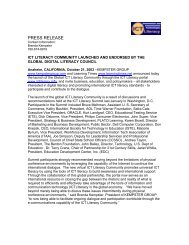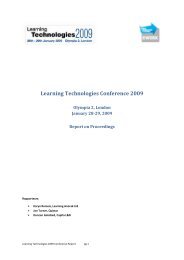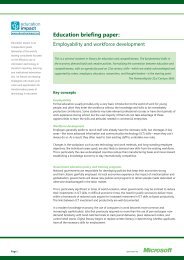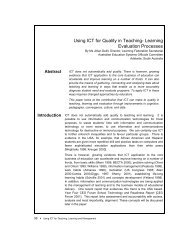147 pages pdf - ICT Digital Literacy
147 pages pdf - ICT Digital Literacy
147 pages pdf - ICT Digital Literacy
Create successful ePaper yourself
Turn your PDF publications into a flip-book with our unique Google optimized e-Paper software.
Pedagogy & Webagogy -- Ready, Set … TRAIN and FACILITATE!<br />
#602: Body Language Tells It All<br />
Before you post directions for an assignment or course, give it to at least two different people to<br />
read (someone who is familiar with the content and someone who is not) and watch their<br />
reactions and body language. By doing this, it will help you identify areas of the assignment that<br />
are unclear ahead of time.<br />
Diana Voss<br />
Stony Brook University<br />
#603: Be There -- And Others Will Too<br />
In my own experience, being "present" within the online course sets the stage for building community and<br />
creating that environment that encourages participation. Usually I will send some kind of an email to kickoff<br />
the week and often will try and get into the thread discussion myself over that same period of time.<br />
People will respond to this and real "conversations" begin to emerge.<br />
Susan Byrne<br />
Brock University<br />
#604: Be Professional<br />
At the outset, agree to a time frame for responding to student questions / problems and stick to<br />
it. To keep students waiting will frustrate them and probably hinder their progress.<br />
Anonymous<br />
#605: Connect 3 Ways<br />
Trust is an essential component in building any learning environment but even more so in an e-<br />
Learning environment where visual cues and body language generally are not the typical norm.<br />
So design the e-Learning space to connect to your learners, connect learners with each other,<br />
and connect learners with their own world so they can make a difference.<br />
Mark Freeman<br />
University of Sydney<br />
#606: Experience = Learning<br />
Remember John Dewey's key point: "All we learn, we learn by experience." Thus, e-Learning is<br />
good, but b-Learning (b for blended) is even better. Make an effort to supplement the "e" of<br />
learning with an on-site application /discussion or some form of "putting the e-Learning to work"<br />
as soon as possible after each e-Learning event. Even better if the "putting-to-work" is on or<br />
close to the job. Better still if with co-workers.<br />
Richard S. Webster, Ph.D.<br />
Abintra LLC<br />
#607: Subject: Read This Now!<br />
Use an action-based subject line in the class reminder emails so that the class enrollee knows that there is<br />
work to be done prior to showing up for the class. This helps lower the rate of unprepared attendees,<br />
expecially for the first-time attendee who needs to run a wizard to prepare for web-conferencing. For<br />
example: Print Your Worksheets! or Prepare Your Computer For Class!<br />
Cheral Stewart<br />
CallSource<br />
#608: Yes, Mixing Online And Face-to-Face Works, Did You Ever Doubt It?<br />
I have found integration of online tools and classroom to be very effective. Participants learn a technique<br />
and then access online tools to build and reinforce the learning using tools to change how they would<br />
approach doing something at work. Some examples include meeting effectiveness evaluation (reinforces<br />
effective meetings), project risk analysis and even brainstorming.<br />
Steven Lesser<br />
InfoWorks International<br />
701 e-Learning Tips by The MASIE Center www.masie.com 120



